SCOLMA Conference on `Hidden Collections in African Studies`
advertisement
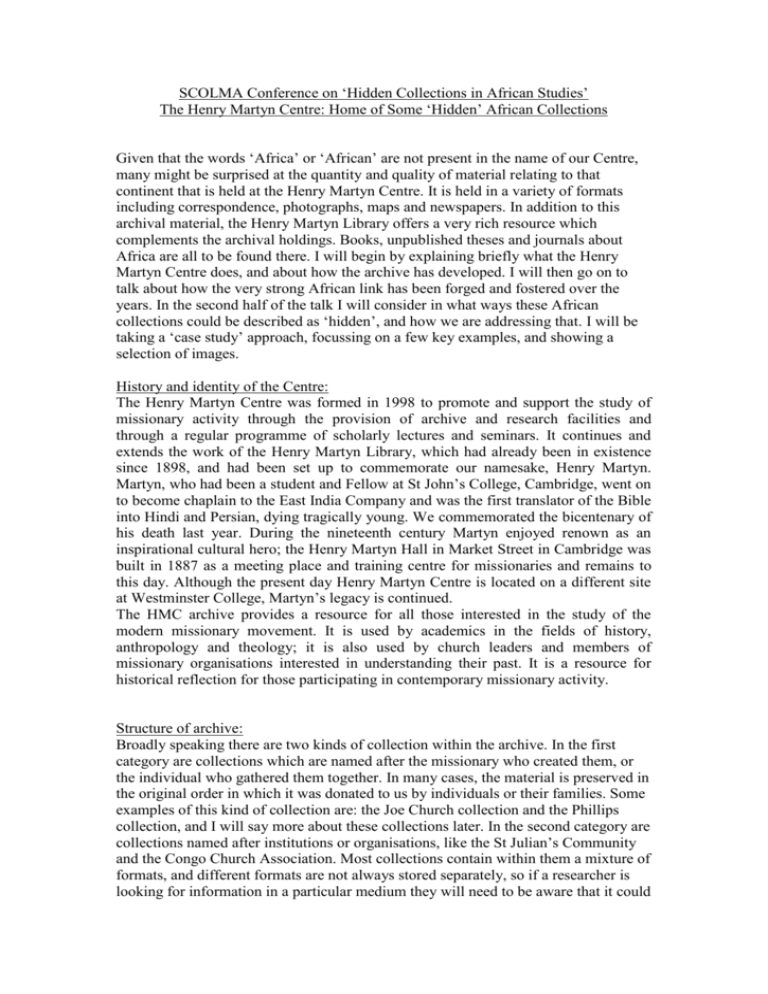
SCOLMA Conference on ‘Hidden Collections in African Studies’ The Henry Martyn Centre: Home of Some ‘Hidden’ African Collections Given that the words ‘Africa’ or ‘African’ are not present in the name of our Centre, many might be surprised at the quantity and quality of material relating to that continent that is held at the Henry Martyn Centre. It is held in a variety of formats including correspondence, photographs, maps and newspapers. In addition to this archival material, the Henry Martyn Library offers a very rich resource which complements the archival holdings. Books, unpublished theses and journals about Africa are all to be found there. I will begin by explaining briefly what the Henry Martyn Centre does, and about how the archive has developed. I will then go on to talk about how the very strong African link has been forged and fostered over the years. In the second half of the talk I will consider in what ways these African collections could be described as ‘hidden’, and how we are addressing that. I will be taking a ‘case study’ approach, focussing on a few key examples, and showing a selection of images. History and identity of the Centre: The Henry Martyn Centre was formed in 1998 to promote and support the study of missionary activity through the provision of archive and research facilities and through a regular programme of scholarly lectures and seminars. It continues and extends the work of the Henry Martyn Library, which had already been in existence since 1898, and had been set up to commemorate our namesake, Henry Martyn. Martyn, who had been a student and Fellow at St John’s College, Cambridge, went on to become chaplain to the East India Company and was the first translator of the Bible into Hindi and Persian, dying tragically young. We commemorated the bicentenary of his death last year. During the nineteenth century Martyn enjoyed renown as an inspirational cultural hero; the Henry Martyn Hall in Market Street in Cambridge was built in 1887 as a meeting place and training centre for missionaries and remains to this day. Although the present day Henry Martyn Centre is located on a different site at Westminster College, Martyn’s legacy is continued. The HMC archive provides a resource for all those interested in the study of the modern missionary movement. It is used by academics in the fields of history, anthropology and theology; it is also used by church leaders and members of missionary organisations interested in understanding their past. It is a resource for historical reflection for those participating in contemporary missionary activity. Structure of archive: Broadly speaking there are two kinds of collection within the archive. In the first category are collections which are named after the missionary who created them, or the individual who gathered them together. In many cases, the material is preserved in the original order in which it was donated to us by individuals or their families. Some examples of this kind of collection are: the Joe Church collection and the Phillips collection, and I will say more about these collections later. In the second category are collections named after institutions or organisations, like the St Julian’s Community and the Congo Church Association. Most collections contain within them a mixture of formats, and different formats are not always stored separately, so if a researcher is looking for information in a particular medium they will need to be aware that it could be scattered in different places. Newspaper holdings, for example, may form part of particular collections depending on who collected or created them (provenance) and so are not always listed separately. There is a very strong provenance component in the structure of our archive. How did HMC’s African connection begin? The African connection has come about through the networks of people with which our Centre has historic links. 1. The first significant collection to be added to the archives was the Hinchliff collection in 1996: they were given to the Henry Martyn Library by Peter Hinchliff’s widow. This came about through the agency of Graham Kings, then Director of the Henry Martyn Centre. Peter Hinchliff was born in South Africa in 1929 and was ordained in the Anglican Church in South Africa in 1952. He taught in a theological college until 1959 when he became Professor of Ecclesiastical History at Rhodes University (1960-1969). He also served as a member of the Faith and Order Commission of the World Council of Churches between 1964 and 1974 and in 1969 to 1972 he was secretary to the Board for Mission and Unity in the Church of England. There are many leaflets and books relating to the Anglican Church in South Africa. 2. We can look much further back too to explain the ‘African connection’. HMC has its roots in the Cambridge tradition of training young men for missionary work in areas that might now be called the former British Empire. This tradition goes back to the days of Charles Simeon, the famous vicar of Holy Trinity Church who ‘recruited’ Henry Martyn. Missionaries whose papers we collected were often nurtured by CICCU and the CMS, and these organisations in turn had links with the colonies in Africa and India. Joe Church is a good example of this kind of missionary. Educated as a doctor at Emmanuel College, Cambridge, he was a founder (with Lawrence Barham) of the Cambridge University Missionary Band. Church went out to Africa in 1927, where he worked at Gahini in Rwanda. There was a hospital and missionary centre at Gahini, which was one of the two stations of the Rwanda Mission, the other being Kabale. In his early days in Africa, Joe Church was supported and advised by Algernon Stanley-Smith, an older missionary also with a Cambridge background. A son of one of the original ‘Cambridge Seven’, StanleySmith was educated at Trinity College, Cambridge, and sailed for Uganda in 1916. He was based at Kabale, western Uganda, in 1921, and his presence in the area was important for Joe Church’s development as a humanitarian. You can read much about this in Quest for the Highest. Joe Church’s collection came to us in 2006 and is an extensive collection of books, papers, sound recordings and photographs. It provides a unique insight into the East African Revival, in which Joe Church played a leading part. 3. The Phillips collection was donated in 1997 with some more recent donations in 2006 and 2007. John and Anne Phillips served in Nigeria and the collection consists of the couple’s researches into the history of the Niger Mission, which was established in Onitsha in 1857 by Bishop Samuel Crowther, the first Bishop of African descent. Within this collection is to be found the photograph collection of Canon Foster (recruited for CMS by Bishop Lasbrey; he became Principal of the Dennis Memorial Grammar School at Onitsha and later Archdeacon of Onitsha). Also papers relating to the life of Archdeacon Tom Dennis. Thomas John Dennis trained with CMS and sailed for Sierra Leone in September 1893. He was transferred to Onitsha in the Niger district of Nigeria in November 1894. He was committed to improving access to education in these countries as well as spreading the word of the Gospel. In Igboland, Nigeria, he completed a new vernacular translation of the Bible, incorporating elements from various dialects. 4. Other African collections are listed on Mundus, though some (Logan, Stanley Good and St Julian’s Community) are not yet. The Logan papers relate to the Egypt General Mission and Stanley Good’s papers relate to the church in Kenya. St Julian’s Community: The St Julian’s Community, set up by Florence Allshorn, had a base in Limuru, Kenya where missionaries could go to reflect and recuperate after the trials of their service. See the book by Richard Frost, A Race against Time: Human Relations and Politics in Kenya before Independence (Rex Collings, 1978) which has an interesting chapter on the St Julian’s Community in Kenya. Frost writes: ‘The story of four women and twenty acres at Limuru is like a microscope under which we can study the fears and emotions, the hopes and prejudices which beset the progress of inter-racial harmony in Kenya.’ (p. 232) Amongst our collection (Box 2) we have the flight log (actually a detailed journal) of Dorothy Alton’s first journey from England to Kenya in 1954. This is fascinating as an account of an intrepid female aviator and her impressions of Africa at the beginning of the post-colonial era. The objects of the St Julian’s (Kenya) Association were defined in a document dated September 1956 as follows: ‘the establishing and upkeep of a retreat and conference house which shall be a place of meeting and rest affording a means of spiritual and physical recuperation for people of all races, and, in such other manner as the Governing Body of the Association may from time to time determine, to advance religious education and knowledge and to provide facilities for the meeting of inter-racial groups for discussion and conference.’ (2/10) Permission for the purchase of the property in Limuru for the St Julian’s Community was not given until June 1957. A cartoon appearing in New Comment the following month depicts the St Julian’s Community as a wooden horse in the White Highlands. Congo Church Association: Papers donated to the Henry Martyn Centre by the Revd Canon William (Bill) Norman and Beryl Norman between 2007 and 2011. Bill Norman served as General Commissary of the Province of the Anglican Church in the Democratic Republic of the Congo from 1992, succeeding Bishop Philip Ridsdale, the first bishop of the Province. He retired in 2011. The Association was formed as the Zaire Church Association by Bishop Philip Ridsdale in 1976. You will see that there are 2 photographs from the Ridsdale collection on my handout. The name of the Association was changed to the Congo Church Association in October 1997 after the name of the country was changed from Zaire to the Democratic Republic of the Congo at the ousting of President Mobutu by Laurent Kabile in May 1997. The collection includes dossiers and reports relating to the changing situation in the Congo, as well as the CCA Newsletter. This newsletter describes various aspects of life in the Congo, including education, healthcare and humanitarian issues. The separate but related collection of Philip Ridsdale’s papers (also at HMC) can be read in conjunction with the CCA archives. This section of the archive is continuously accruing. What about Africans in the archives? 1. Erica Sabiti, first African Archbishop in the Anglican Communion. In 1966 he succeeded Leslie Brown, leading a province consisting of Uganda, Rwanda, Burundi and Boga Zaire. Some of his letters in the Joe Church collection. Involved in the Balokole movement, which advocated public confession and purity of life. Includes a letter from JEC and Erica Sabiti, 24 September 1962 to Haile Selassi, and a photograph of Sabiti with Haile Selassi. 2. William Nagenda. Son of a Christian Muganda chief. Worked as a ‘free evangelist’ and accompanied Joe Church on tours of France, Germany, Switzerland, Nyasaland, UK and the USA. It was controversial that Joe Church included him as an equal partner on these tours. We have letters to and from William and Sarah Nagenda in a section of the archive called ‘Leaders of the Revival’ which also includes material relating to Sabiti. 3. Nagenda’s brother in law, Blasio Kigozi, had also been a very inspirational figure who took a leading part in the 1935 Kabale Convention, and made a fervent address to the 1936 Synod in Kampala on the need for repentance and revival. How are we opening up these ‘hidden’ collections? 1. Through Mundus. 2. Through a ‘Spotlight on the archives’ feature on our website. I recently made a posting about newspapers in the archive, drawing attention to our complete set of Information, published by the colonial administration in Kampala, Uganda, during the Second World War. This is part of the Leech collection. The Henry Martyn Centre also holds copies of Muigwithania, the newspaper of the Kikuyu Central Association, dating from 1928-29. Copies of the original language publication and the translations into English made for the use of the colonial administration in Kenya are both held. 3. Seminars advertised on our website and by leaflets distributed around Cambridge. 4. Cataloguing in Cantab which will produce files to be uploaded to Janus, the Cambridge archives portal. 5. Considering a digitisation programme to make more widely available selected highlights of the Joe Church collection, particularly a 56 page booklet called Awake! An African Calling: the Story of Blazio Kigozi: this is the first edition of what was later called Awake! Uganda! This 1937 first edition is rare (a copy at Oxford is effectively inaccessible). Our copy has some endpapers covered in Joe Church’s annotations that we would like to have copied.
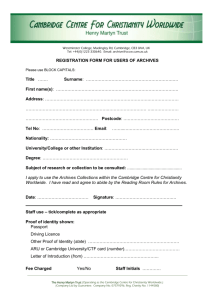
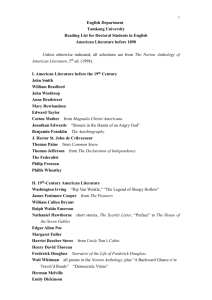
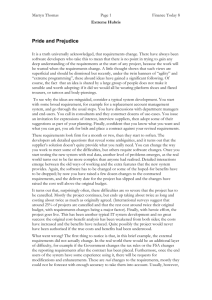
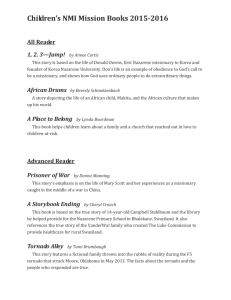




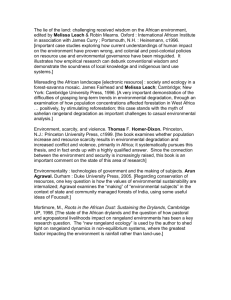

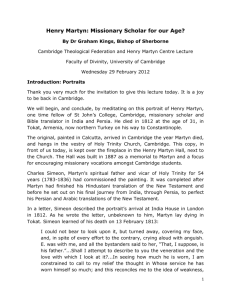
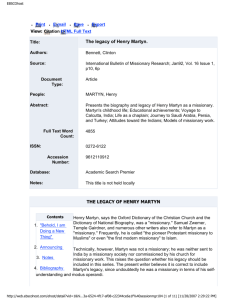
![This article was downloaded by: [University of Warwick] Publisher: Routledge](http://s2.studylib.net/store/data/013208092_1-3c759d37002e727be3a7be9c61ba402c-300x300.png)